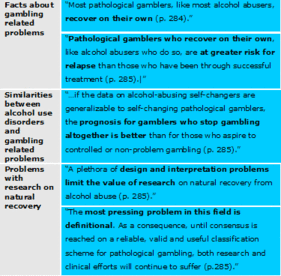It is sometimes difficult for people who experience gambling related problems to find a suitable treatment program, pay for services and schedule large amounts of time to attend meetings and sessions; like smokers who have quit, a large proportion of people likely rely upon self-directed or natural recovery to change their gambling behaviors. Natural recovery refers to the process by which individuals with maladaptive behaviors (e.g., alcohol use disorders, drug abuse, gambling related problems) attain a state of recovery without the help of a formal or informal treatment program. There is some evidence that natural recovery is a fairly common process for both gambling and substance use disorders (Nathan, 2003). This week, the WAGER reports on a recent review that uses evidence about natural recovery from alcohol use disorders to inform research on natural recovery from gambling disorders (Nathan, 2003).
A very limited body of research describes individuals with gambling problems as more likely to recover without treatment. Hodgines, Wynne, and Makarchuk (1999) reported that four of six adults reporting a gambling problem in 1997 in Alberta, Canada recovered without treatment. Hanninen and Koski Jannes (1999) analyzed fifty-one autobiographical stories of recovery from addictions and concluded that many individuals naturally recover from a variety of conditions, including gambling related problems. Given the dearth of research on natural recovery among those with gambling related problems, Nathan (2003) looked at alcoholism research for comparisons. Nathan selected alcoholism because (1) it is the most common co-occurring clinical disorder with gambling disorders and (2) like gambling disorders, it co-occurs with a large variety of other clinical disorders.
Research on natural recovery from alcohol dependence reveals that most people struggling with this problem become abstinent on their own, without formal (e.g., psychotherapy) or informal (e.g., Alcoholics Anonymous) help (Sobell, Sobell, & Toneatto, 1992; Vaillant, 1995; Watson & Sher, 1998). From his review of the literature, Nathan summarizes findings linking the natural recovery of alcohol use disorders and gambling disorders; he also suggests ways to improve future research on natural recovery. Table 1 illustrates some of his conclusions about recovery from gambling disorders, the similarities between gambling and alcohol use disorders, and problems associated with natural recovery research.
Table 1. A sample of conclusions from a brief review of natural recovery in alcoholism (Nathan, 2003).

This review of the research reveals some important observations regarding natural recovery and its relationship to gambling disorders. As Nathan notes, these conclusions and suggestions about natural recovery for gamblers rests upon a small body of evidence. While acknowledging “the paucity of research on natural recovery from pathological gambling” (Nathan, 2003, p. 281), Nathan generalizes from the alcohol literature by suggesting that natural recovery represents the most common form of recovery and those who recover naturally have reduced rates of abstinence. Nathan offers caveats about generalizing from small studies that rely on self report by noting, for example, that this method produces “confusing variability” (Nathan, 2003, p. 283). There is considerable work to do to improve our understanding of natural recovery from gambling disorders by using alcohol research. For example, it will be important to identify the similarities and differences between alcohol use disorders and gambling problems to optimally understand the process of natural recovery from either.
Natural recovery from gambling disorders likely represents the primary path to recovery for most people who experience excessive gambling; however, more research is required to clarify this process and the extent to which it occurs. A logical next step would be to heed the advice of Nathan by resolving research design flaws (e.g., reliance on self-reports, homogenous research subject populations, etc.) and work to establish new standards for research on natural recovery. Perhaps, we might learn from future research on natural recovery processes about the factors that differentiate those who recover successfully from those who do not. By integrating knowledge about these factors, clinicians can advance the efficacy of professional treatment and self-help programs.
Comments on this article can be addressed to Mike Stanton.
References
Hanninen, V., & Koski-Jannes, A. (1999). Narratives of recovery from addictive behaviours. Addiction, 94(12), 1837-1848.
Hodgins, D. C., Wynne, H., & Makarchuk, K. (1999). Pathways to recovery from gambling problems: Follow-up from a general population survey. Journal of Gambling Studies, 15(2), 93-104.
Nathan, P. E. (2003). The Role of Natural Recovery in Alcoholism and Pathological Gambling. Journal of Gambling Studies, 19(3), 279-286.
Sobell, L. C., Sobell, M. B., & Toneatto, T. (1992). Recovery from alcohol problems without treatment. In
N. Heather & W. R. Miller & J. Greely (Eds.), Self-control and the addictive behaviors (pp. 198-242). New York: Maxwell Macmillan.
Vaillant, G. E. (1995). The natural history of alcoholism revisited: Cambridge, MA, US: Harvard University Press. (1995). xiii, 446pp.
Watson, A. L., & Sher, K. J. (1998). Resolution of alcohol problems without treatment: Methodological issues and future directions of natural recovery research. Clinical Psychology: Science and Practice, 5, 1-18.




